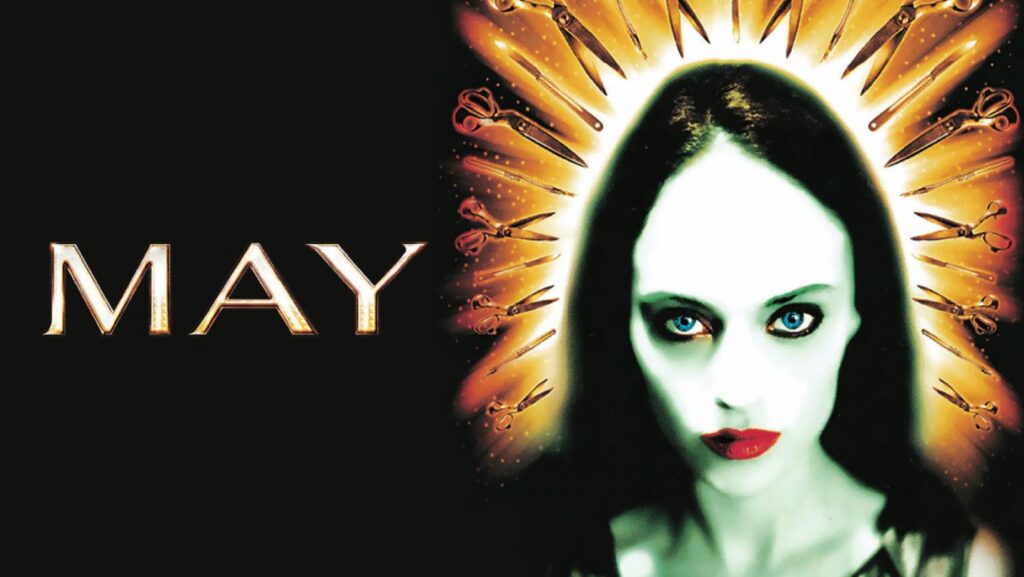A bloody, empty eye socket. The strangest Vet in cinema history. A bloody pair of scissors. A collection of body parts. Somehow, to this day, these compiled images make up one of the most honest, realistic depictions of Bisexuality and Pansexuality to date. Director Lucky McGee’s May might not have appeared like anything other than indie horror fare to audiences at release. Still, this tragic gorefest of an indie drama is oft-forgotten and underlooked as a queer allegory.
Angela Bettis’ Haunting Portrayal of a Queer Antihero in May
The film follows the titular protagonist, May, played beautifully by Angela Bettis. Bullied growing up for her lazy eye and strange demeanor, May’s only true friend was an eerie glass doll named Suzie. As an adult Veterinarian, she lives as a lonely introvert, awkwardly yearning for romantic attention. But as rejections build up, she begins to act violently, murdering those who mistreat her, and collecting body parts of failed romantic prospects to build a comfort of her own.
The film is a beautifully sad, mumblecore horror story that feels like a 2000s indie flick like Ghost World drenched in blood, with a tad of Carrie and Tim Burton thrown in for good measure. However, what is very little remembered is the film’s queer subtext. May herself is casually queer, and the film’s morbid finale is a clearcut analogy for bisexual desire.
The Subtle Power of May’s Approach to LGBTQIA+ Themes
What is fascinating about May is how casually it approaches its LGBTQIA+ subject matter. Unlike other films at the time, which usually made gay characters the butts of jokes, or when being sympathetic usually became trauma porn, May approached the subject maturely.
Most queer characters were additionally shoved into binary boxes of gay or straight, with bisexuality being a rare, if ever-thought-about concept. If a character had a same-sex interest, they were either confused and straight, or on the verge of having a gay awakening.
May is offbeat for many reasons, with her strange interests, shy demeanor, and lazy eye. Still, her experience with bullying and dealing with a hateful world stands parallel to the queer experience.
Breaking Binary Norms: Bisexuality in Early 2000s Cinema
May herself is bisexual, vying for affection both from men and women in the film. However, it is never obviously stated and forcefully approached. She just is, without it ever being a point of contention and something to be reckoned with. Her outsiderness, and feelings of lack of belonging resonate strongly with Queer audiences. Yes, she is a violent, murderous psychopath, which may not strike all Queer audience members fondly, but it is a deeply metaphoric allegory, a tragic story of a girl searching for belonging. Without the blood and guts, it would probably sit alongside dramedies of the time more akin to Juno.
Despite the bloodshed, what helps cement this character as a relatable one is how it truly is a stream-of-consciousness film. The movie focuses on its titular character the entire time, never leaving her headspace or treating her like a villain. Despite the deplorable actions done to characters who probably just needed a slap to the face instead of a knife to the neck, the movie creates a bleak atmosphere for her headspace. The world of May is a cold, uncaring, lonely place, and despite the violent overreactions, she feels justified every single step of the way.
May is, without a doubt, a complicated, deep character, her violent flaws a product of an unloving society. It is not hard to see the comparisons to more traditionally gay or bisexual protagonists, despite this one being written through the lens of some nasty kills.
The Metaphoric Frankenstein of Pansexual Longing in May
Throughout May, Angela Bettis’ character went through a plethora of victims. A young punk (James Duval) with a Frankenstein tattoo, snobby filmbro Adam (Jeremy Sisto) and his Girlfriend (Nora Zehetner), her Lesbian co worker Polly (Anna Faris), and Polly’s Girlfriend Ambrosia (Nichole Hiltz). Her murders seem to fall in line with her romantic interests, gender not seeming to matter in the slightest.
An androgynous punk, a straight couple, and a Lesbian couple all fall victim and simultaneously all interest her romantically. Her final act, teased throughout the film, is taking select body parts from each person to create her one true love, a Frankenstein’s Monster of a doll named Amy. After ripping out her own lazy eye (gross) and placing it on her creation, she has created a terrifying metaphor for pansexual or bisexual longing.
Pansexuality, essentially, is similar to but different than Bisexuality. It is an attraction to a person without any care for gender, whether they be cis, trans, non-binary, or any other gender identity. May seems to care only for these people’s souls, what gender they are is not as significant. At the end of the day, though, she chooses masculine and feminine characteristics alike to create an androgynous, genderless lover. It is an interesting symbol of queer longing, her attraction simultaneously existent for specific body parts of men and women alike, but also to make a creation that is ultimately neither.
May is definitely dated in some regards, yet it is miles ahead of its time. Its nuanced look at queerness, and morbid symbolism that is more sad than scary, makes it a cult classic. This pride month, May might be the perfect gem to watch. It is, pun intended, a dissectible film, to say the least, and has much more to say than 2002 audiences may have anticipated.
